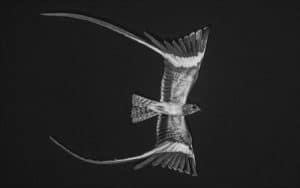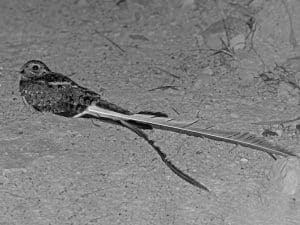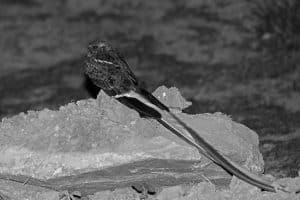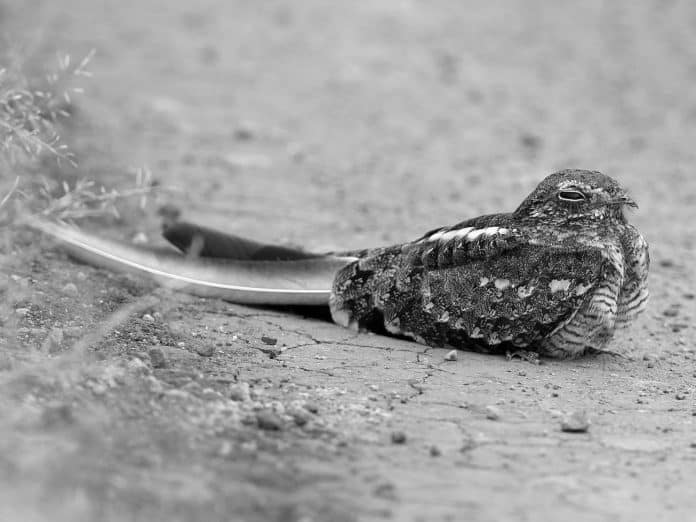Introduction to the Pennant-Winged Nightjar
The pennant-winged nightjar in Tanzania is a medium-sized bird that belongs to the family Caprimulgidae, which is also known as the nightjar family. This species is found in sub-Saharan Africa, from Senegal to Ethiopia and down to South Africa. The bird’s name comes from the long, pointed feathers on its wings, which resemble pennants or flags. These feathers can be raised and lowered, giving the bird greater control over its flight.
The pennant-winged nightjar is a nocturnal bird, meaning that it is active at night and rests during the day. During the day, it can be found roosting on the ground or on a low branch of a tree, where it blends in perfectly with its surroundings. The bird’s plumage is predominantly brown, with black and white markings on its wings and tail. Its large eyes are adapted to low light conditions, allowing it to see and capture prey in the darkness.
Habitat and Distribution of the Pennant-Winged Nightjar in Tanzania
In Tanzania, the pennant-winged nightjar is found in a variety of habitats, including savannas, woodlands, and forests. It is most commonly found in the northern and eastern parts of the country, including the Serengeti and Tarangire National Parks. The bird prefers areas with open spaces and scattered trees, where it can hunt for insects on the wing.
The pennant-winged nightjar is a migratory bird, spending the breeding season in the northern parts of its range and moving south during the non-breeding season. In Tanzania, the bird is present from November to March, when it can be seen performing its impressive aerial displays in the night sky.
Characteristics and Behavior of the Pennant-Winged Nightjar

The pennant-winged nightjar is known for its unique physical features and behaviors. As mentioned, its wings have long, pointed feathers that can be raised and lowered, allowing the bird to control its flight. This gives it the ability to perform impressive aerial acrobatics, such as hovering, darting, and diving, as it hunts for insects in the air.
The bird’s call is also distinctive, consisting of a series of rapid, high-pitched notes that are repeated in a regular pattern. The call can be heard throughout the night in areas where the bird is present.
The pennant-winged nightjar is a solitary bird, usually seen alone or in pairs. During the breeding season, males will perform aerial displays to attract females. The female will then lay two eggs on the ground, where they are incubated for around three weeks. The young birds are born with downy feathers and are able to leave the nest after a few days.
The Aerial Acrobatics of the Pennant-Winged Nightjar
One of the most fascinating aspects of the pennant-winged nightjar is its aerial displays. These displays are performed by the male bird during the breeding season, as a way to attract a mate. The displays involve a series of impressive acrobatics, including hovering, darting, and diving, as the bird hunts for insects in the air.
The pennant-winged nightjar’s unique physical features, such as its long, pointed wing feathers, give it the ability to control its flight and perform these aerial displays. The bird’s call can also be heard during these displays, as it repeats a series of high-pitched notes in a regular pattern.
Witnessing the aerial acrobatics of the pennant-winged nightjar is a truly awe-inspiring experience. As the bird darts and dives through the night sky, it is a testament to the beauty and wonder of the natural world.
Best Places to Spot the Pennant-Winged Nightjar in Tanzania
If you want to witness the aerial acrobatics of the pennant-winged nightjar for yourself, there are several places in Tanzania where you can do so. The Serengeti and Tarangire National Parks are both excellent locations to spot the bird, as they offer open spaces and scattered trees, which are ideal for the bird’s hunting behavior.
Other good locations include the Ngorongoro Conservation Area and Lake Manyara National Park. These areas are also home to a variety of other bird species, making them great destinations for birdwatchers.
Tips for Nightjar Watching in Tanzania

Nightjar watching in Tanzania can be a rewarding and unforgettable experience, but it does require some preparation and planning. Here are some tips to help you make the most of your nightjar watching experience:
- Choose a reputable tour operator who has experience in nightjar watching and who follows responsible tourism practices.
- Wear warm clothing and bring a flashlight or headlamp with a red filter, which will not disturb the birds.
- Be patient and quiet, as the birds are easily disturbed by noise and movement.
- Listen for the bird’s call, which will help you locate it in the darkness.
- Respect the bird’s natural habitat and behavior, and do not disturb or harass the birds in any way.
Other Fascinating Bird Species in Tanzania
Tanzania is home to over 1000 bird species, making it a paradise for birdwatchers. In addition to the pennant-winged nightjar, there are many other fascinating bird species to be found in the country. Some of the most notable include:
- African Fish Eagle
- Lilac-breasted Roller
- Grey Crowned Crane
- Kori Bustard
- Secretarybird
Conservation Efforts for the Pennant-Winged Nightjar
The pennant-winged nightjar is currently listed as a species of least concern by the International Union for Conservation of Nature (IUCN). However, like many bird species, it is threatened by habitat loss and fragmentation, as well as by disturbance from human activities.
Conservation efforts for the pennant-winged nightjar include protecting its natural habitat and raising awareness about the importance of responsible tourism practices. By respecting the bird’s natural habitat and behavior, we can help ensure that it remains a part of Tanzania’s rich biodiversity for generations to come.
The Importance of Responsible Tourism in Nightjar Watching

Nightjar watching can be a wonderful and rewarding experience, but it is important to remember that we are visitors in the bird’s natural habitat. By following responsible tourism practices, we can minimize our impact on the environment and help ensure that the bird’s natural behavior is not disturbed.
Responsible tourism practices for nightjar watching include choosing a reputable tour operator, respecting the bird’s natural habitat and behavior, and avoiding activities that may disturb the bird, such as using bright lights or making loud noises.
Conclusion: Awe-Inspiring Encounters with the Pennant-Winged Nightjar in Tanzania
In conclusion, the pennant-winged nightjar is a fascinating bird species that can be found in Tanzania’s diverse and beautiful landscapes. With its unique physical features and impressive aerial displays, it is a testament to the beauty and wonder of the natural world.
By following responsible tourism practices and respecting the bird’s natural habitat and behavior, we can help ensure that the pennant-winged nightjar remains a part of Tanzania’s rich biodiversity for generations to come. So, whether you’re a seasoned birdwatcher or a casual nature enthusiast, be sure to add the pennant-winged nightjar to your list of must-see species in Tanzania.

































